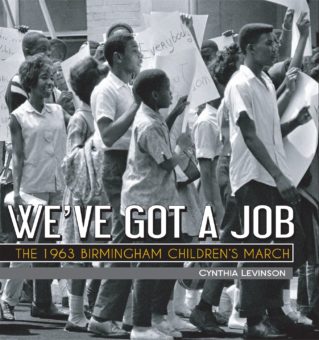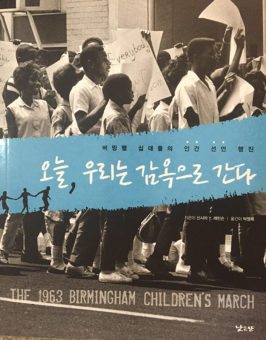The four young marchers, the multiple photos, and the dramatic story provide dozens of ways for reluctant–or, as I prefer to say, uneasy–readers to get into We’ve Got a Job. The Teacher’s Guide and Lesson Plans provide lots of pre-reading Discussion Starters and activities for kids to connect with the book.
Here’s a list of additional ideas that appeal to Uneasy (sometimes called “Reluctant”) and other Readers:
- Have students draw a picture of a jail. Ask, “Who goes to jail? What happens to people in jail?”
- Look at the cover photo. Ask, “What do you think these kids are doing? How do you think they feel?” Read the title of the book and ask, “What kind of job might they be doing?”
- Turn to page 1 (the first page after the Table of Contents) and read the verse of the song. Discuss what kinds of jobs the students do. Can they imagine a job that would free people?
- Tell students that the children on the cover are going to jail. Discuss why they might do that. Is there anything they care about so much that they would go to jail, if that would help?
- Read the Prologue through the sentence, “And why would she get arrested at church?” Have students brainstorm answers to the questions in that paragraph.
- Have students write on cards or dictate to you what “freedom” means to them. Do the same thing with the opposite of “freedom.” Post the cards around the room. Then, look at the picture of Audrey on page 5–they can carry their books around the room–and ask which kind of freedom they think she wants. Did they come up with the kind of lack of freedom that Audrey experienced?
- Read the Table of Contents, focusing on the quotations. Have students write a question about the quotation. They can then look for the answer when they read that chapter.
- Read the sub-heads in Chapter One. Ask, “What might ‘Negroes and white persons not to play together’ mean?” Discuss “Separate But Equal” (pages 8 and 9).
- If Washington Booker were a fictional character, he might be the one reluctant readers gravitate toward. Even better–he’s real! Read Chapter Two with the students. What do they think about his mother beating him? Is there something in their lives that they’re terrified of? How does it compare to Bull Connor?
- After students read Chapter Four, ask them to predict how Wash felt about going to church. Then, have them read the three subsections on pages 39-42 (“‘Having a Hallelujah Time,’” “‘There was a Bomb,’” and “Shadrach, Meshach, and Abednego”). Are they surprised? They can also listen to what Wash said about Christianity and the Civil Rights Movement (audio link to come).
- Have students find “Booker III, Washington” in the Index, on page 172. Divide the students into groups and have each group go to a page or group of pages where Wash is mentioned and learn what he did. The groups can share what they learned, then line up in chronological order, and tell Wash’s story. They can publish a timeline of Wash’s adventures, using timeglider.
- After students read the first four chapters, help them develop a skit or write a dialogue among Audrey, Wash, Arnetta, and James. What would they say to each other if they went swimming together in James’ pool? What might happen if Wash tried to order a banana split at Newberry’s? Act out Audrey’s watching her mother wrap the soft white bear for another child. Act out Klansmen chasing James and Arnetta’s training in nonviolence.
- Have students compose tweets of what Audrey, Wash, James, or Arnetta is thinking and doing between April 29 and May 6, 1963.
- Watch the Trailer. Talk about what else was happening in Birmingham on May 2, 1963. Ask students why they think freedom was up to the children?
- Students can develop their own trailer for free, using Animoto.
- Hand out quotations from Dr. King, such as “There are those who write history. There are those who make history.” Ask students to give an example of the quotation from (1) the book, (2) their own lives, (3) the world. Students can share their responses and build on each others’ using wallwisher.
- Discuss the sidebar on page 52 (“Points for Progress”). Have students make picket signs with these demands.
- Read the first sub-head and the first two paragraphs of Chapter Seven. Discuss: Whose fault was segregation?
- Read the first two sections of Chapter Seven. Hold a debate on the issue “Resolved: Children should not disobey the law.” The debate can be live and in-class or conducted by Fakebook postings.
- Look at the sidebars on page 64 (“Arrests Plummet”), page 65 (“Project C Sinks”), page 106 (“Headline News”), page 123 (“Dueling Press Statements”), and page 126 (“The Biracial Agreement”), and the newspaper headlines on this website. Students can make their own free magazine covers of the news events, using Big Huge Labs.
- If you’re a member of Pinterest, kids can draw or search for and then post pictures of the Children’s March.
- Each student can choose her or his favorite scene and make an online poster of it using Glogster EDU. Or, they can display their favorite section of chapter of the book through a free comic strip.
- Then, they can quiz each other about their favorite scenes by developing a free Jeopardy game.
- Have the class choose the most emotional–frightening or moving–scene. Then, help them present it as a “frozen tableau.”
- Bring the issues home. Ask students whether or not bullying deprives people of their rights, as Ann Angel did, and discuss what they would be willing to do to stop bullying.
- Pair We’ve Got a Job with a work of fiction, such as The Watsons Go to Birmingham by Christopher Paul Curtis.
- Ask, “What’s YOUR job?”
- March! Sing!
Feel free to send me your ideas to review and post. I’ll be delighted to credit you!

Learn More:
Resources for Teachers Resources for Kids Awards ReviewsBuy Now:
BookShop Indiebound Barnes & Noble Amazon.com First Book Kindle
